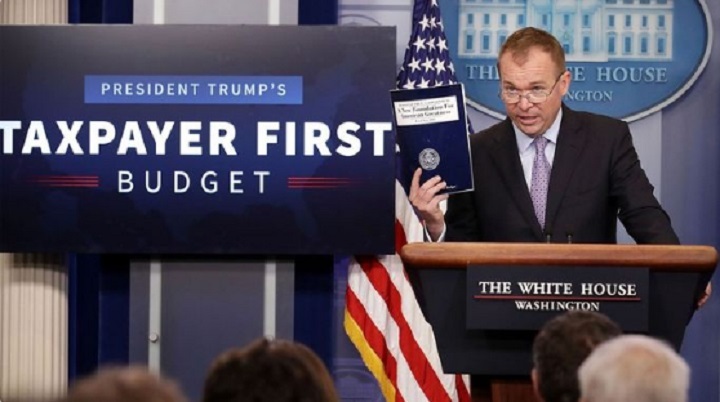By dipping into funds meant for safety net programs for America’s poor, Trump is being a “reverse robin hood” of sorts by returning this money to the defense industry and already wealthy taxpayers.
With clear depiction by Mick Mulvaney, Trump’s budget director, the largest savings in the budget come from the following items:
- Medicaid cuts that total over $600 Billion in the next decade
- SNAP to be implemented, a food stamp cut of $193 Billion over 10 years
- Student Loans cuts of $143 Billion over 10 years
- Cuts to retirement programs for federal workers
Mulvaney most likely forgot a fifth point, as disability programs have also received a massive cut in funding. Advocates for the poor are perplexed by the size of such cuts.
As one of the leading activists for low-income families in Washington, the Center on Budget and Policy Priorities confirms, it’s a “reverse Robin Hood agenda”.
Who Benefits From Trump’s Decisions?
Although the Trump administration is defending their position by claiming their new agenda as a “taxpayer first” budget, it’s hard to believe that the typical American family would benefit. With such little detail released, even tax policy experts are unable to determine whether the middle class stands to gain or lose. The only thing that is known thus far, is that the wealthy, including Trump himself, will likely have to fork over less of their paycheck in taxes.
Joe Rosenberg, senior research associate at the Tax Policy Center chimes in, “The majority of the benefits go to high-income people”.
In addition to lowering the tax rates on top performing businesses and high income individuals, the Trump administration also eliminated Obamacare surcharge on wealth investors. While half of America has no extra money to invest into the stock market, Trump is granting investors that earn over $200,000 a year with a further tax break.
Arguably the most significant perk that the rich have received, is the elimination of estate tax. Although right now it only applies to properties evaluated at over $5.5 million, Trump wants to get rid of t entirely.
Estate taxes are assessed when hers are given property by those that pass away. The intergenerational transfer of wealth, is one of the main reasons behind America’s great inequality.
Even Wall Street Is Surprised
Predicting that the budget will eventually hit a “brick wall” in the US Senate, chief strategist at Horizon Investments, Greg Valliere wrote, “This is the centerpiece of the spending proposal — cuts of nearly $1 trillion over 10 years in Medicaid, food stamps and other anti-poverty programs.”
With nearly over 1 in 10 relying on food stamps, and 1 in 5 Americans on medicaid, senators know the extent to which these programs facilitate the low income in the country.
An alarming number of those on government aid programs voted for Trump. Including the critical state of Florida, 7 of the the 10 states that have the greatest proportion of residents on food stamps voted in favour of Trump.
Apart from slashes to food stamps and medicaid, Social Security Disability Insurance has also undergone heavy losses. Along with cuts done in Temporary Assistance to Needy Families, the Trump administration has reduced financing to crucial programs that help physically challenged individuals, and families in need of welfare.
Mulvaney argues that Trump can get millions of people back to work, so they won’t have to rely on government aid. As he continued on Monday, “We believe in the social safety net… If you’re on food stamps and able-bodied, we need you to go to work”.
However, the main complaints coming from business owners is not simply a lack of workers, but a lack of “skilled” workers to employ. Although some people coming off of government aid are able-bodied, their environment may not have been conducive to their learning, resulting in a lack of human capital necessary for the technologically advancing market.
“We are essentially back at full employment,” chimes head of American Action Forum Douglas Holtz. “I just don’t think we’ll move more people from government rolls to work.”
Something Doesn’t Add Up
Balancing the budget requires reforming programs such as Social Security, or Medicare. And although Trump has promised not to detriment either during his campaign, the president has already backtracked by proposing cuts to Social Security Disability Insurance. However, Mulvaney describes these moves as different issues from Social Security directed at the elderly.
On top of all the funding cuts to programs, Trump has added $54 Billion in spending on defense, whilst issuing “the biggest tax cut in the history of this country.” With all of these forces at play, there’s little left of the rest of the budget. Liberals have shown heavy opposition to the idea of cutting social welfare programs such as food stamps that many American children rely on.
Just about every economist agrees that the education of our youth breeds innovation, and effectively training the leaders of tomorrow are crucial contributions to growing the economy. As such, moderate conservatives are wary of cuts to education and scientific work.
In the words of Holtz-Eakin, Trump’s budget serves to eliminate “all of the domestic discretionary funding where you genuinely invest in the future: education and basic research.”
The budget thus far has proved detrimental to the poor, show tremendous upside for those already wealthy, and leaves the middle class in the gray.
Featured Image: twitter










